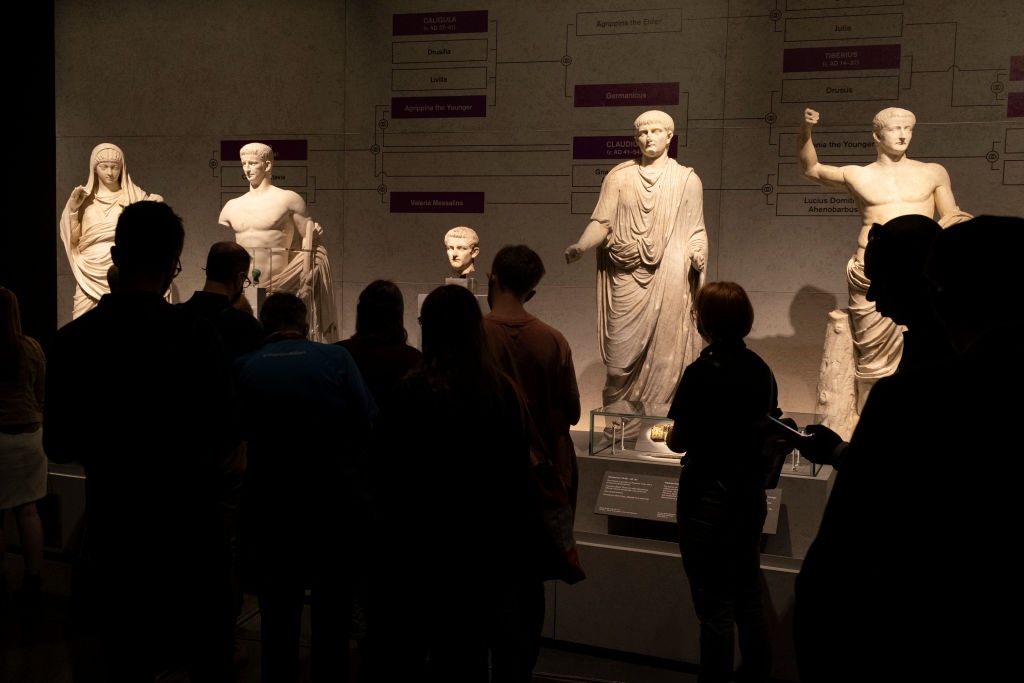Puckish polymath
Italo Calvino’s imagination spanned the cosmos but his concerns were very human
This article is taken from the November 2023 issue of The Critic. To get the full magazine why not subscribe? Right now we’re offering five issues for just £10.
The fictional worlds created by the Italian polymath Italo Calvino, who was born 100 years ago this month, attract adjectives not usually applied to serious literature. Puckish. Playful. Charming. But that is what you get with this author whose extraordinary intelligence never undermined his desire to entertain — to charm and disarm — the reader.
Calvino was a writer whom opposites attracted. He was always serious and frequently funny. His mode was specifically Italian and thoroughly international. He was first a realist, then an experimenter. And his interest in his fiction was in looking both inward and outward: as far outward as the furthest reaches of the known universe.
But he began at home, and the best way to appreciate Calvino’s peculiar genius is to trace the development of his writing, which can be divided into two broad phases. From his early work in the 1940s to 1963, he wrote realistic, socially engaged stories, usually set in the Italian countryside where he grew up. (His parents moved to Italy from his birthplace of Cuba when he was one year old.)
His first novel, The Path to the Spiders’ Nest (1947) remains in print because it is by Calvino rather than for any intrinsic qualities. The author was embarrassed by its success and regretted the failure of the book — about an adolescent boy joining the partisan movement during the Second World War — to transmute the base metal of his own experiences into literary gold.
At the same time — through the 1940s and 50s — Calvino was turning out short stories at such a rate that they fill a handful of collections in English, most notably Difficult Loves, Last Comes the Raven and Adam, One Afternoon. These stories are seductive enough, but their status is marked by the fact that they weren’t translated into English until after the major works — mostly, indeed, until after Calvino’s death, when the rush for scraps from the table that has characterised his literary estate to this day first began. (The most recent new collection of his early stories was published in 2023.)
No, the first signs of Calvino’s true calling came in the trio of novellas he published in the 1950s: The Nonexistent Knight, The Cloven Viscount, and his first masterpiece The Baron in the Trees. These tempered their realist style with allegorical purposes and fantastical elements: The Cloven Viscount, about a man split in two by cannon shot and whose two halves continue to live independently, was inspired by the divisions of the Cold War. The Baron in the Trees, about a boy who climbs a tree and lives there for the rest of his days, represented Calvino’s own view — head in the trees, if not the clouds — that writers should remain above politics.
He returned to earth only for his last realist work, Marcovaldo (1963), a collection of stories representing a season in the city over a period of five years — and, incidentally, a good starting place for the Calvino beginner. The title character is a labourer who strives for fine things but rarely with success: the first story about foraging for mushrooms in the streets is a masterpiece of desire, resentment, achievement and regret, all in four pages.
But the break came with Calvino’s next books, the two collections of what he called Cosmicomics, published in the late 1960s. Always interested in science — his parents were agronomists — the writer who never repeated himself decided not only to look up from the city streets, but to extend his gaze to outer space.
It’s a measure of not only Calvino’s originality but his ability to render that originality in an aesthetically pleasing form, over and over again, that his most celebrated books are also his most experimental; and the Cosmicomics stories reflected Calvino’s belief that realistic fiction was a busted flush.
Narrated by a seemingly immortal being with the unpronounceable name of Qwfwq, each story begins with a scientific theory, verified or apocryphal, and spins a story out of it. “The Distance of the Moon” takes as a springboard George H. Darwin’s belief that the moon was once close to earth: in Calvino’s rendering, people can prop a ladder against the moon and climb onto its surface, only for lovers to be parted when she begins to drift away.
Or take “All at One Point”, which returns to the origins of the universe before the Big Bang, when Qwfwq and his family find living conditions rather crowded. There is a classic Calvino-esque comic tinge to it all: Qwfwq may not be human but he is very human-like, and mankind is the only animal that laughs.
The Cosmicomics stories, drawing on influences as diverse as “the Popeye comics, Samuel Beckett, Giordano Bruno [and] Lewis Carroll”, freed Calvino’s imagination, and all the fiction he wrote afterwards was evidence of what he called his “need to alternate one type of writing with another, to begin writing again as if I had never written anything before”. Indeed, he wrote as if nobody had ever written anything before, so groundbreaking were the results.
The Castle of Crossed Destinies (1969) was a novel comprising a series of stories told using the cards of a tarot deck, and was typically ingenious. But it was his next book, Invisible Cities (1972), that ensured his place in the literary firmament. It consisted of 55 descriptions of imaginary cities, as reported to Kubla Khan by Marco Polo. There’s Thekla, a city always under construction; Zenobia, a city on high pilings where nobody ever descends to the ground; Sophronia, where half the city is regularly folded up and put away; and so on.
This is not just a series of pretty pictures in words, but a manifesto for Calvino’s vision of the world. The stories shift from fantastical at the beginning to cautionary at the end. The mutually exclusive cities resemble Italy’s history of distinctive city-states. We see the cities as an outsider through Marco Polo’s words, but the descriptions are exclusively internal, of how the citizens live there: each perspective is at once separate from, and dependent on, the other. The duality is classic Calvino. As John Updike put it, “beneath Calvino’s tireless shimmer of fancy, the concern [is] of how men live together”.
T
hen came his most famous book, the novel If on a winter’s night a traveller (1979). It opens, irresistibly, “You are about to begin reading Italo Calvino’s new novel, If on a winter’s night a traveller. Relax. Concentrate. Dispel every other thought.” The book is a celebration of reading, both tongue-in-cheek and devoted, which alternates sections describing “your” experience of reading the book, with opening chapters from ten imagined novels.
Here, Calvino was explicitly displaying his interests in both inner space and the wider world, even if his outward gaze on this occasion only extended as far as the bookshelves lining his room. (This book was the inspiration for David Mitchell’s celebrated 2004 novel Cloud Atlas: Mitchell sought to go one better than Calvino by completing his series of stories-within-stories, where Calvino left each opening chapter hanging. Mitchell was wrong: completing things kills them. It’s not knowing that keeps us going.)
All Calvino’s greatest fiction was elegantly translated into English by William Weaver, who did not always have a smooth experience. “I had problems with Calvino,” he said, “because he thought he knew English.” Calvino would “fall in love” with English words, not knowing what they really meant, such as “feedback” which he kept trying to add to the English translation of the last book published in his lifetime, Mr Palomar. (Weaver kept taking it out, and won the battle, when Calvino died before it was complete.)
Mr Palomar (1983) is a good place to finish. It can be usefully contrasted with Marcovaldo, the last novel Calvino published before his great revolution of the late 1960s. Both books comprise the adventures of an everyman encountering the wider world, but in Mr Palomar the naturalistic style is replaced with something more philosophical. This is a book of attention to everything, structured with three stories per chapter: the first visual and descriptive, the second anthropological and narrative, and the third speculative and meditative.
But even in the scientific approach, there is comedy
But even in the scientific approach, there is comedy. In the story “The Naked Bosom”, our hero makes so many attempts not to look at a sunbathing woman’s breasts that she eventually covers up and moves away. The last story of the twenty-seven in the book begins, deliciously, “After a series of intellectual misadventures not worth recalling …”
And finally Mr Palomar lives up to Calvino’s own definition of a classic in his famous essay “Why Read the Classics?”, of “a book that has never finished saying what it has to say”. It has relevance to our times, and not only in its evergreen philosophical themes of man’s relations to the universe. But how better to render our own times — and how better to conclude a career, following his early death in 1985 at the age of 61, than like this?
“In a time and in a country where everyone goes out of his way to announce opinions or hand down judgements, Mr Palomar has made a habit of biting his tongue three times before asserting anything. After the bite, if he is still convinced of what he was going to say, he says it. If not, he keeps his mouth shut. In fact, he spends whole weeks, months in silence.”
Enjoying The Critic online? It's even better in print
Try five issues of Britain’s most civilised magazine for £10
Subscribe














